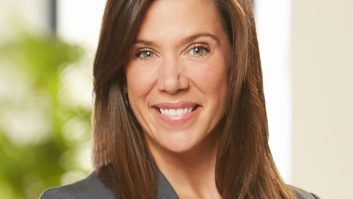Unlike other new store formats for Best Buy, or any other chain for that matter, the tour of the Westminster location in the L.A. area was more about the people and less about brick-and-mortar design.
As part of Best Buy’s annual financial analysts meeting, the chain provided tours to the analysts and media attendees of locations in and around the Southern California area. The press was part of a three-hour morning tour of the Westminster location, which featured two of the Consumer Centric departments: Home Theater Experience and Best Buy For Business.
The core of the Consumer Centric strategy is that the “customer is king,” and anyone who is close to the customer is “royalty,” namely sales associates and store managers. The corporate types back at company headquarters in Richfield, Minn. are furthest from the customer and are the “support team.” As far as salaries go, “royalty,” i.e. sales associates, are being paid what they always have been paid at Best Buy, with corporate officers still getting the big bucks. Will that change? More about that later.
While the bulk of the investment for Best Buy involves training and hiring the right sales associates, there were subtle changes in this store vs. a typical Best Buy, so much so that the chain asked the press not to take pictures.
The whole look of the store was far more wide open and less cluttered, especially in the movie, music and software areas. Large posters all over the store featured lifestyle themes and stressed how different products could entertain, educate or solve problems, rather than emphasizing price or technical details. Wall colors, and the posters themselves, were tan, muted gold and brown, making this store look less like the typical warehouse style of Best Buy with its industrial lighting and its series of cubical product departments.
The approach is that this Best Buy is more of an upscale store, and the new paint, posters and layouts seem to achieve that goal.
As for the departments themselves, the Home Theater Experience is where the old sound room was at this location, featuring three family or living room layouts and top-of-the-line HDTV displays, DVD or hard disk recorders and sound systems. In the Home Theater Experience, and in every department, each customer has “one point of contact” — one sales associate that follows up with the customer after the sale. Westminster store personnel said that the same sales associate that sells you your home theater system will also be there with the installation crew to make sure everything is running fine … and to suggest another product or an accessory or two.
The Best Buy For Business department is more than just computers. It illustrates the freedom store managers and department managers have in merchandising. The Westminster team has identified most of its small business customers as real estate salespeople, and therefore have a selection of packages with laptop computers, digital cameras, cellular phones and printers, in various configurations. The department features around 30 laptop SKUs, about double for the usual Best Buy store.
Best Buy executives have targeted this area for growth because the chain said it is a market of almost $58 billion. Best Buy has sales of $2.5 billion in that area currently.
Not seen by this reporter at the Westminster store, but discussed at a briefing after the tours, was the personal shopping assistants for “Jill,” described as a suburban soccer mom with a couple of kids and a better than $100,000 household income. In those stores there are also “Just for Kids” departments with children’s products. Two California “Jill” stores are located in Pasadena and Porter Ranch.
Each morning, a couple of hours before opening, sales associates and managers meet in a “Chalk Talk” session to review the previous day’s performance by department. Comp store sales, ROIC (return on investment capital), basis points, margins and the like are discussed and reviewed.
The personnel at the Westminster store seemed to be genuinely enthusiastic and ranged in age from their mid-20s to the mid-30s. Just about all of the personnel had been employed at the store since before the test began in the middle of last year. On the surface, these sales associates seemed to have been trained at some fast-track MBA academy and had more than one financial analyst and member of the press blown away with their financial knowledge. (In reality, each sales associate has 30 days of training.)
And there are 15 percent more sales associates at each Consumer Centric location, in part to identify customers that fit the demographics each department is trying to sell.
Speaking of the bottom line, there were plenty of numbers thrown at the analysts during the meeting, for the stores on the tour, for all the Consumer Centricity stores, projections on how it effects Best Buy down the road, etc. Here are a few that this reporter thought were very significant, which were provided by executive VP/finance and chief financial officer Darren Jackson.
During Best Buy’s most recent fiscal fourth quarter, comp store sales for traditional Best Buy stores were up 10 percent, but in the Consumer Centricity stores they were up 17 percent; the average transaction in the traditional stores was $100, while at the Centricity stores it was $104; and the sales close rate was 51 percent for traditional, but 57 percent for the new Centricity locations. Profitability, measured in basis points, also improved dramatically.
If Best Buy is successful in training its people in this new format, what’s going to keep most of them with the chain and not move to a competitor to get a higher paycheck? In an informal Q&A with vice chairman Brad Anderson, he was asked by one analyst, “How will you keep your people? Will you look at commissions again?” Anderson candidly said that this aspect of Consumer Centricity “is still being developed” and it “may be an issue our human resources department will have to tackle.”
For Consumer Centricity to be successful, the cost of training and keeping good people may be central to the strategy’s success or failure.












